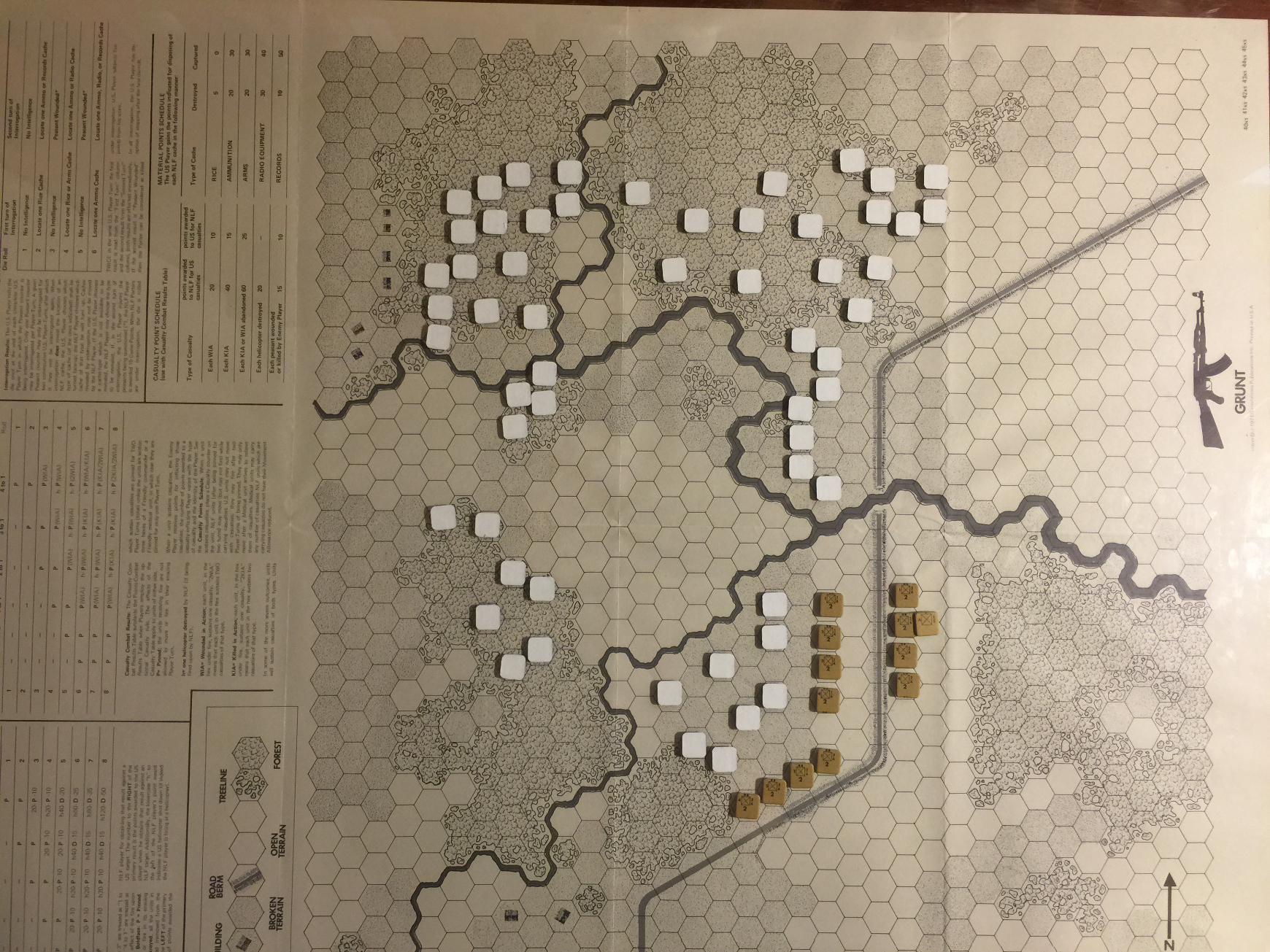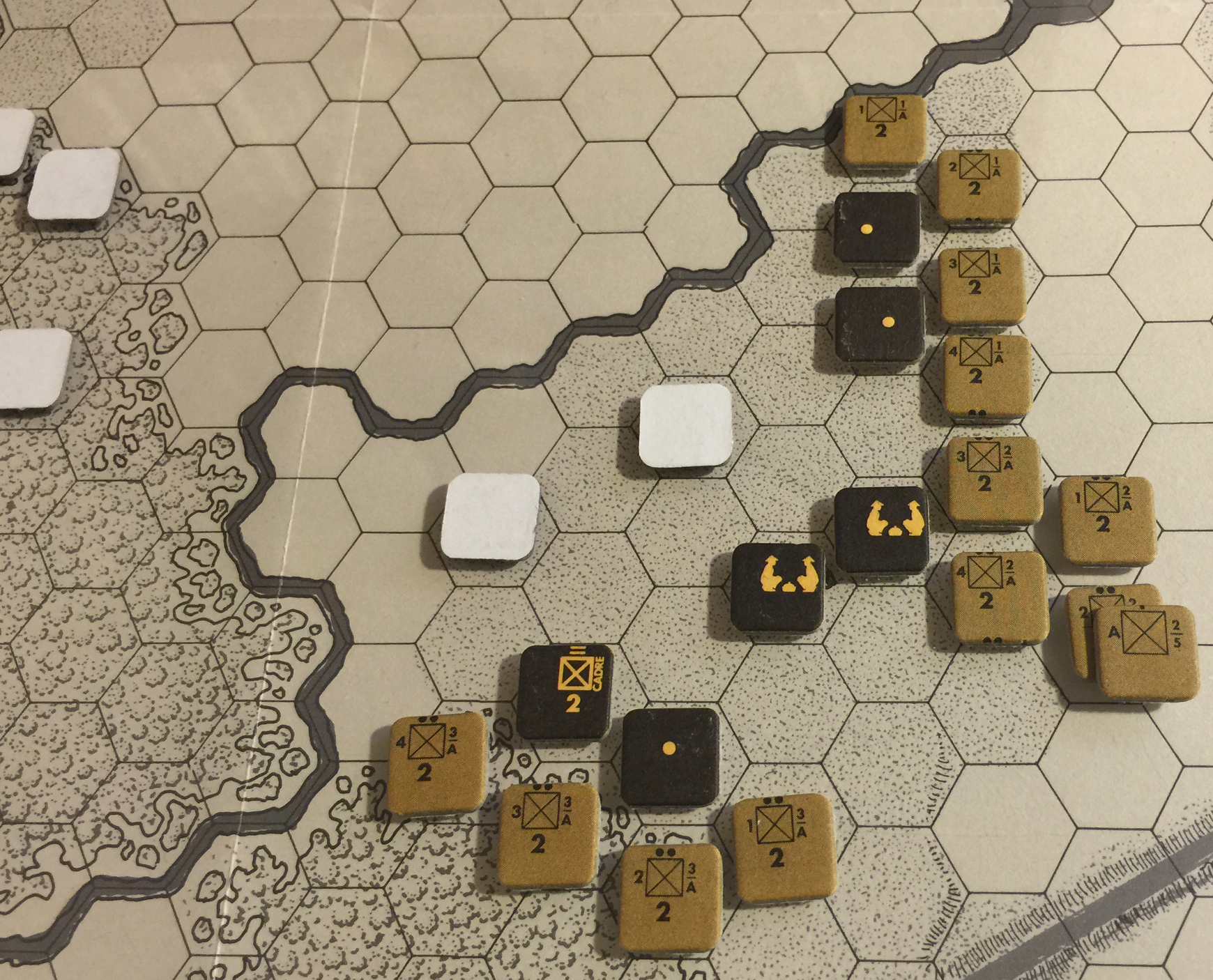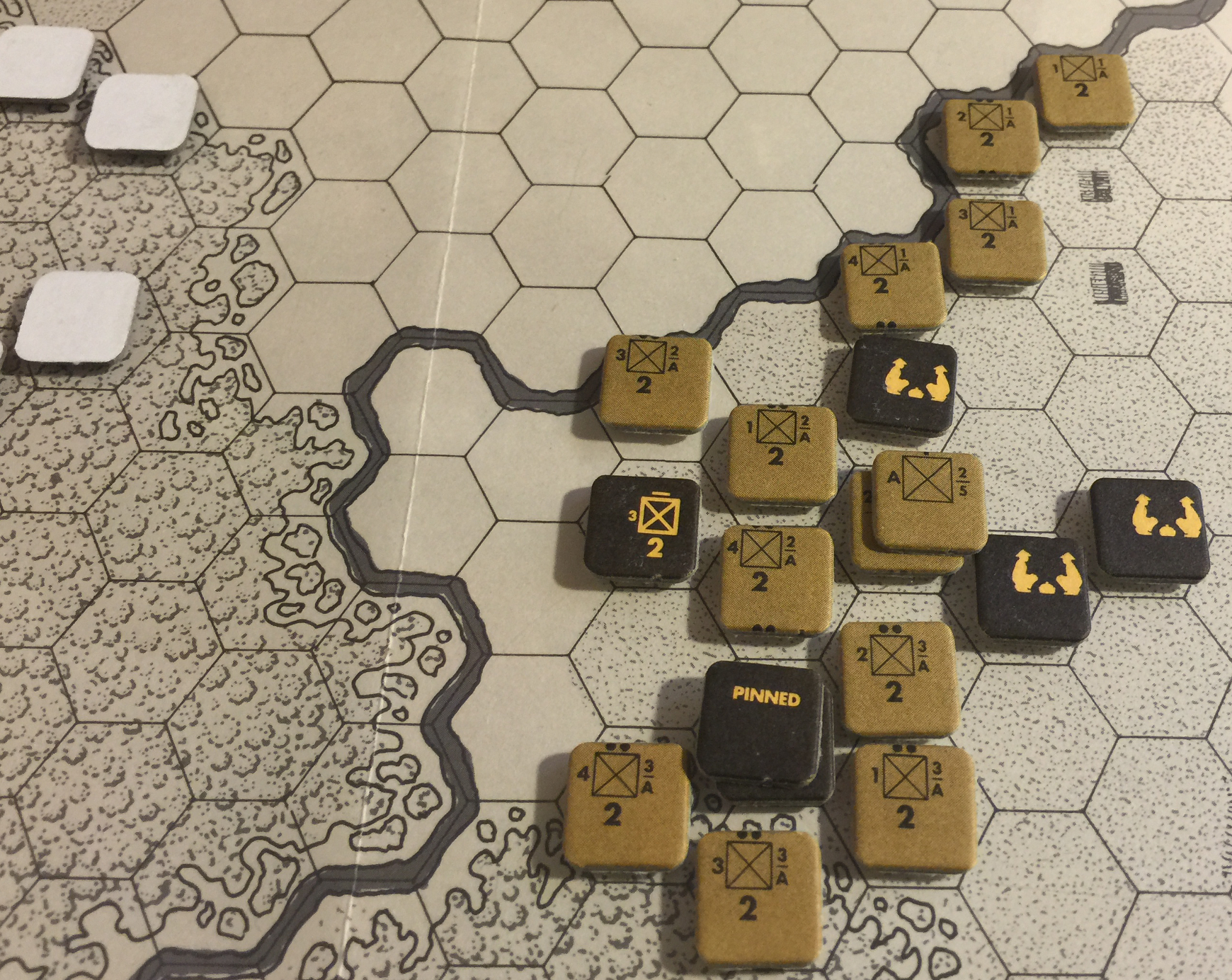A first look at Grunt
Tags
One of the earliest Vietnam games I know of is SPI’s Grunt (1971), which simulate very small unit operations during the Vietnam War. By “small” I mean company level operations with squads as the fire and maneuver elements. One can certainly simulate at even lower levels, but it would seem odd to me to task a single platoon for an operation. Platoons just don’t have enough support.
The rules for Grunt are not the easiest to assimilate, in part because the game is as much a small “game system” as it is any single game. The following situations or scenarios are very briefly described in the rules:
- Solo game.
- Basic two player game.
- Standard two player game.
- Chain of Command Situation 1: Search and Destroy.
- Chain of Command Situation 2: Secure Landing Zone.
- Chain of Command Situation 3: Eagle Flight.
- Roll your own situation given appropriate orders of battle and command orders as outlined in the Chain of Command situations.
Along with these situations, the NLF have the following order of battle options: Basic Game, Mobile Base Camp, Mobile Training Camp, Day-to-Day, Supply Depot, Inf. Company, NLF Held Area.
Accompanying the situations and orders of battle, there are also a long list of optional rules covering Strengthened Defense, Move & Fire, Ammunition and Supply, Reconnaissance-by-fire, Casualty Combat Results (with associated medics), Ambush, Artillery, Forward Observation, Fire Effects, Fields of Fire, Airstrikes and more.
There’s quite a bit of game play here, since (apparently) the Chain of Command orders, optional rules and NLF order of battles can be mixed and matched. Balance is achieved via handicapping. For example, landing an entire company at once gives the NLF player 75 victory points. The US going into an NLF Held Area gives the US player 100 victory points.
However, it should be noted, the rules are not that clear, and are not what would be considered well-organized 45 years after publication. Hence, it’s not altogether clear how to put together a viable solitaire situation. We’ll have to let common sense rule the day.
Game play overview
Fundamentally, Grunt is an IGOUGO system, with one player having exposing units only when firing or fired upon. The US player is brought in by abstract helicopters, which may be shot down by NLF as a reaction when US forces land. The optional rules provide a lot of chrome, but nothing unduly difficult. Games should play pretty fast, the biggest holdup being the NLF player being able to remember his deployment or check units quickly. At least one person made blocks for NLF for convenience. Counter sleds might work, albeit those are hard to stack.
Turn sequence
US Turn
Movement Phase
All US and ARVN units have 6 MF.
Combat Phase
US units which have not moved (optionally spent 3 or less MF) may fire.
Clear Pinned Units
Remove Pinned markers from units pinned during NLF combat phase.
NLF Turn
Movement Phase
All NLF combat units and (unloaded) Porters may move 6 hexes per turn.
Combat Phase
US unit on NLF Ambush marker gives +2 DRM on combat roll to NLF.
Clear Pinned Units
Remove Pinned markers from units pinned during US combat phase.
End of Turn
Update running score for each side.
This turn sequence is deceptively simple. Where more modern games break out actions such as supply and air actions, these activities are buried in one of the phases, and the player has to work out the appropriate sequencing. From the rules, such activities aren’t complicated, but care needs to be taken to keep track.
Setting up
The solitaire game has us set up all the NLF, Peasants and Dummy counters on the board, face down. We’re going to use the Basic Rules and Basic Game US deployment, which is 12 squads and a company commander. The US forces in Grunt consist of a two company battalion. We’ll use A Company without the platoon leaders (i.e., the platoon leader counters won’t go on the map).
Turn 1
The NLF is already on the map, the US needs to land some forces. The US goal is to clear a lane across the map to control access across the central open area dividing the western forks of the river.
US Player Turn
US lands in the southeast sector.
Movement Phase
All US and ARVN units may move 6 hexes per turn.
Here’s the situation:

The company commander is moving with 2d platoon.
Combat Phase
No combat this turn.
NLF Player Turn
Solo game, NLF sits tight.
Movement Phase
All NLF combat units and (unloaded) Porters may move 6 hexes per turn.
No movement for hidden NLF in solo game.
Combat Phase
No combat this turn.
End of turn bookkeeping
Score: NVA 75, US 0.
Turn 2
The US is on the ground, time to sweep.
US Player Turn
Start the sweep by moving west.
Movement Phase
All US and ARVN units may move 6 hexes per turn.
-
1st platoon moves north and west to flank suspected NLF positions.
-
2d platoon moves across road and to the west.
-
3rd platoon moves to southwest flank of suspected NLF positions.
3 positions have no NLF, 2 are occupied by peasants, and an NLF cadre is uncovered in the southwest.
Combat Phase
US may not fire on NLF units exposed during the same turn movement. Generally, units may fire or move during a single turn, but not both.
NLF Player Turn
Movement Phase
All NLF combat units and (unloaded) Porters may move 6 hexes per turn.
No movement for NLF in solo game.
Combat Phase
NLF fires on squad 4, 3rd platoon which is in the trees, hence defense 3 so odds 1:2 roll 1 no effect.
End of turn bookkeeping
Here’s the situation with the dummy counters still on the board:

Score: NLF 75, US 0.
Turn 3
US Player Turn
Movement Phase
All US and ARVN units may move 6 hexes per turn.
-
1st platoon establishes an overwatch position looking northwest across clearing.
-
2d platoon moves across huts to check another potential MLF position.
-
1st and 2d squads move up to flank cadre, 3d and 4th squads hold.
Combat Phase
3rd squad fires, 1:1 into broken terrain. 4th squad holds fire as peasants are in firing line. Roll 5, NLF pinned for 10 pts US. NLF may not move or fire this turn.
NLF Player Turn
Movement Phase
All NLF combat units and (unloaded) Porters may move 6 hexes per turn.
Combat Phase
End of turn bookkeeping
- Remove Pinned markers.
- Update running score for each side.
Score: NLF 75, US 10.
Turn 4
US Player Turn
US is blocked up by the NLF Cadre. That’s a high priority to clear out.
Movement Phase
All US and ARVN units may move 6 hexes per turn.
- 1st holds in overwatch.
- 2d platoon moves up to clear southwest quadrant.
- 3rd platoon remains engaged in firefight with cadre unit, while moving up squads 1 & 2 for next turn engagement.
Combat Phase
Firing with squads 3 & 4, 2:1 odds roll 6 for pin and US 10 points. Crossfire result would 1:2 odds on everything, which is a pin for 5 & 6, but would have no effect on the peasants in line of fire. The pin result would not matter on friendly forces as the pin markers get removed at end of turn.
NLF Player Turn
No actions since cadre unit is pinned.
Movement Phase
All NLF combat units and (unloaded) Porters may move 6 hexes per turn.
No movement this turn.
Combat Phase
Cadre unit is pinned.
End of turn bookkeeping
- Remove Pinned markers.
- Update running score for each side.
Score: NLF 75, US 20.
Turn 5
US Player Turn 5
Movement Phase
All US and ARVN units may move 6 hexes per turn.
2d Platoon moves up, another NLF unit exposed.
Combat Phase
US units which have not moved (optionally spent 3 or less MF) may fire.
3rd platoon lights up the cadre at 4:1, roll 4 for pinned, score 10 more points.
NLF Player Turn 5
Not much to do in solo game.
Movement Phase
All NLF combat units and (unloaded) Porters may move 6 hexes per turn.
No movement in solo game.
Combat Phase
US unit on NLF Ambush marker gives +2 DRM on combat roll to NLF.
NLF 3 fires on 3rd squad 2d platoon, which is in the clear, 2:1 roll 2 miss.
Clear Pinned Units
- Remove Pinned markers from units pinned during US combat phase.
End of Turn 5
- Update running score for each side.
Score: NLF 75, US 30.
Here’s the situation at the end of Turn 5:

The US is all jammed up around NLF forces.
Turn 6
As can be seen from the situation at the end of Turn 5, the US is at a bit of an impasse with respect to the rules for solitaire play. Since half of two platoons are restricted from moving until the NLF units are eliminated, and it takes a 6 on 4:1 column to eliminate, the game is pretty much of a lock for the US at the moment. The NLF will have to have to get lucky trading shots back and forth to run up the score on their behalf. Let’s see what happens trading fire with these units as 1st platoon moves into the treeline to the west.
US Turn 6
As noted above, the US is at a bit of an impasse but could trade fire and possibly win.
Movement Phase
All US and ARVN units have 6 MF.
- 1st platoon moves west.
Combat Phase
- US units which have not moved (optionally spent 3 or less MF) may fire.
- 2d platoon fires at 3:1 roll 5 pinned for 10 more points.
- 3rd platoon fires at 4:1 roll 5 for eliminated and 20 more points. 3rd platoon is now free to move next US movement phase.
Clear Pinned Units
- Remove Pinned markers from US units pinned during NLF combat phase.
NLF Turn 6
NLF is now in a bind, being pinned so cannot score any points.
Movement Phase
All NLF combat units and (unloaded) Porters may move 6 hexes per turn.
No movement for NLF.
Combat Phase
US unit on NLF Ambush marker gives +2 DRM on combat roll to NLF.
NLF pinned, no fire.
Clear Pinned Units
- Remove Pinned markers from units pinned during US combat phase.
End of Turn
- Update running score for each side.
Score: NLF 75, US 60.
Turn 7
Looking bad for NLF.
US Turn 7
Movement Phase
All US and ARVN units have 6 MF.
- 1st platoon moves west to uncover more potential NLF.
- 3rd platoon moves west into wooded area.
Combat Phase
US units which have not moved (optionally spent 3 or less MF) may fire.
2d platoon fires on NLF 3, roll 5 at 3:1, pinned score 10 points. US has had some lucky rolls, nothing below 4 on fire combat yet.
Clear Pinned Units
Remove Pinned markers from units pinned during NLF combat phase.
No pinned units.
NLF Turn 7
NLF unit has a shot at pinning one of the US units in the open.
Movement Phase
All NLF combat units and (unloaded) Porters may move 6 hexes per turn.
No movement this game.
Combat Phase
US unit on NLF Ambush marker gives +2 DRM on combat roll to NLF.
Firing on 1st squad 1st platoon, roll 4 at 1:1 pinned.
Clear Pinned Units
Remove Pinned markers from units pinned during US combat phase.
End of Turn 7
- Update running score for each side.
Score: NLF 75, US 70.
Turn 8
Almost surely the US will be able to get 5 more points to score a victory here.
US Turn 8
US is getting bored, time to score it up and get out of here.
Movement Phase
All US and ARVN units have 6 MF.
- 1st platoon moves squad 4 to engage next turn.
- 3rd platoon crosses river.
Combat Phase
US units which have not moved (optionally spent 3 or less MF) may fire.
- 2d platoon fires roll 5 at 3:1 which is a pin for 10 points.
- 1st platoon fires roll 6 at 2:1 which is a pin for 10 points.
Clear Pinned Units
Remove Pinned markers from units pinned during NLF combat phase.
NLF Turn 8
Pretty much game over for NLF, but we’ll play it out anyway.
Movement Phase
All NLF combat units and (unloaded) Porters may move 6 hexes per turn.
Nothing to move.
Combat Phase
US unit on NLF Ambush marker gives +2 DRM on combat roll to NLF.
Everything pinned.
Clear Pinned Units
Remove Pinned markers from units pinned during US combat phase.
End of Turn 8
Update running score for each side.
Score: NLF 75, US 90.
Turn 9
Nothing much to say here.
US Turn 9
Continue doing what works.
Movement Phase
All US and ARVN units have 6 MF.
- 3rd platoon finds nothing (dummy).
Combat Phase
US units which have not moved (optionally spent 3 or less MF) may fire.
- 2d platoon at 3:1 roll 3, NLF pinned.
- 1st platoon at 2:1 roll 2, no effect! Finally, the NLF get a break.
Clear Pinned Units
Remove Pinned markers from units pinned during NLF combat phase.
1st squad 1st platoon unpinned.
NLF Turn 9
NLF have a very small chance of getting a few more points and even, dice permitting, a very narrow win.
Movement Phase
All NLF combat units and (unloaded) Porters may move 6 hexes per turn.
Nothing to move.
Combat Phase
US unit on NLF Ambush marker gives +2 DRM on combat roll to NLF.
Fire 1:1 on 1st squad, roll 6 and pin for 20 points! Back in the game…
Clear Pinned Units
Remove Pinned markers from units pinned during US combat phase.
End of Turn 9
Update running score for each side.
Score: NLF 95, US 90.
Turn 10
All of a sudden, the US needs to get a little bit lucky, lest a victory be snatched right away.
US Turn
US is just going to continue to fire and not move anything into range of concealed NLF, which could allow a free hit on the US. Mission almost over, why risk anything?
Movement Phase
All US and ARVN units have 6 MF.
Nothing to move, we go straight to firing.
Combat Phase
US units which have not moved (optionally spent 3 or less MF) may fire.
- 2d platoon fires at 3:1 roll 2, pin.
- 1st platoon fires at 2:1 roll 2, miss! NLF snatched a victory.
Clear Pinned Units
Remove Pinned markers from units pinned during NLF combat phase.
NLF Turn
NLF won, let’s see by how much.
Movement Phase
All NLF combat units and (unloaded) Porters may move 6 hexes per turn.
No movement.
Combat Phase
US unit on NLF Ambush marker gives +2 DRM on combat roll to NLF.
- Cadre 3 at 2:1 roll 1, miss.
- VC Militia at 1:1 roll 4 pin but no points.
Clear Pinned Units
Remove Pinned markers from units pinned during US combat phase.
End of Turn
Update running score for each side.
Score: NLF 95, US 90.
 o
o
This was actually quite fun, despite the work it took to unscrew the rules.
AAR
Despite the somewhat boringness of the solitaire rules, I think I rather like the system. It’s simple, should play pretty fast with two player who know the rules, and there is enough optional what-would-now-be-called “chrome” to keep it interesting.
Given the reliance on hidden units and bluffing, it would be a bit of work to drive out a decent solitaire system. But it could probably be done. Not sure it’s worth it other than an exercise in design.